-
TAS5721 Digital Audio Power Amplifier With EQ, DRC, 2.1 Support, and Headphone/Line Driver
- 1 Features
- 2 Applications
- 3 Description
- 4 Revision History
- 5 Device Comparison Table
- 6 Pin Configuration and Functions
-
7 Specifications
- 7.1 Absolute Maximum Ratings
- 7.2 ESD Ratings
- 7.3 Recommended Operating Conditions
- 7.4 Thermal Information
- 7.5 Electrical Characteristics - I/O Pin Characteristics
- 7.6 Master Clock Characteristics
- 7.7 Speaker Amplifier Characteristics
- 7.8 Headphone Amplifier and Line Driver Characteristics
- 7.9 Protection Characteristics
- 7.10 I2C Serial Control Port Requirements and Specifications
- 7.11 Serial Audio Port Timing
- 7.12 Typical Characteristics
- 8 Parameter Measurement Information
-
9 Detailed Description
- 9.1 Overview
- 9.2 Functional Block Diagram
- 9.3
Feature Description
- 9.3.1 Power Supply
- 9.3.2 I2C Address Selection and Fault Output
- 9.3.3 Device Protection System
- 9.3.4 Clock, Auto Detection, and PLL
- 9.3.5 PWM Section
- 9.3.6 SSTIMER Functionality
- 9.3.7 2.1-Mode Support
- 9.3.8 PBTL-Mode Support
- 9.3.9 I2C Serial Control Interface
- 9.3.10 Dynamic Range Control (DRC)
- 9.3.11 Bank Switching
- 9.3.12 Serial Data Interface
- 9.3.13 DirectPath Headphone/Line Driver
- 9.4 Device Functional Modes
- 9.5 Programming
- 9.6
Register Maps
- 9.6.1 Clock Control Register (0x00)
- 9.6.2 Device ID Register (0x01)
- 9.6.3 Error Status Register (0x02)
- 9.6.4 System Control Register 1 (0x03)
- 9.6.5 Serial Data Interface Register (0x04)
- 9.6.6 System Control Register 2 (0x05)
- 9.6.7 Soft Mute Register (0x06)
- 9.6.8 Volume Registers (0x07, 0x08, 0x09, 0x0A)
- 9.6.9 Volume Configuration Register (0x0E)
- 9.6.10 Modulation Limit Register (0x10)
- 9.6.11 Interchannel Delay Registers (0x11, 0x12, 0x13, and 0x14)
- 9.6.12 Pwm Shutdown Group Register (0x19)
- 9.6.13 Start/stop Period Register (0x1A)
- 9.6.14 Oscillator Trim Register (0x1B)
- 9.6.15 BKND_ERR Register (0x1C)
- 9.6.16 Input Multiplexer Register (0x20)
- 9.6.17 Channel 4 Source Select Register (0x21)
- 9.6.18 PWM Output MUX Register (0x25)
- 9.6.19 DRC Control (0x46)
- 9.6.20 Bank Switch and EQ Control (0x50)
-
10Application and Implementation
- 10.1 Application Information
- 10.2 Typical Application
- 10.3 System Examples
- 11Power Supply Recommendations
- 12Layout
- 13Device and Documentation Support
- 14Mechanical, Packaging, and Orderable Information
- IMPORTANT NOTICE
TAS5721 Digital Audio Power Amplifier With EQ, DRC, 2.1 Support, and Headphone/Line Driver
1 Features
-
Audio Input/Output
- 10 W x 2 into 8 Ω With PVDD = 24 V
- 8 W x 2 + 12 W x 1 into 8 Ω With PVDD = 24 V
- Supports 2.0, Single Device 2.1, and Mono Modes
- Supports 8-kHz to 48-kHz Sample Rate (LJ/RJ/I2S)
- Integrated DirectPath™ Headphone Amplifier and 2 VRMS Line Driver
- Audio/PWM Processing
- Independent Channel Volume Controls With 24-dB to Mute in 0.5 dB Steps
- Separate Dynamic Range Control for Satellite and Sub Channels
- 21 Programmable Biquads for Speaker EQ
- Programmable Two-Band Dynamic Range Control
- Support for 3D Effects
- General Features
- I2C™ Serial Control Interface Operational Without MCLK
- Configurable I2C Address (0x34 or 0x36)
- Automatic Sample Rate Detection
- Thermal and Short-Circuit Protection
- Wide PVDD Supply Range (4.5 V to 24 V)
2 Applications
LED/LCD TVs, Soundbar, Docking Stations, PC Speakers
3 Description
The TAS5721 is an efficient, digital-input audio amplifier for driving 2.0 speaker systems configured as a bridge tied load (BTL), 2.1 systems with two satellite speakers and one subwoofer, or in PBTL systems driving a single speaker configured as a parallel bridge tied load (PBTL). One serial data input allows processing of up to two discrete audio channels and seamless integration to most digital audio processors and MPEG decoders. The device accepts a wide range of input data formats and sample rates. A fully programmable data path routes these channels to the internal speaker drivers.
The TAS5721 is a slave-only device, receiving all clocks from external sources. The TAS5721 operates with a PWM carrier frequency between a 384-kHz switching rate and a 288-KHz switching rate, depending on the input sample rate. Oversampling, combined with a fourth-order noise shaper, provides a flat noise floor and excellent dynamic range from 20 Hz to 20 kHz.
An integrated ground centered DirectPath™ combination headphone amplifier and 2VRMS line driver is integrated in the TAS5721.
Device Information(1)
| PART NUMBER | PACKAGE | BODY SIZE (NOM) |
|---|---|---|
| TAS5721 | HTSSOP (48) | 12.50 mm × 6.10 mm |
- For all available packages, see the orderable addendum at the end of the data sheet.
Output Power vs. PVDD in 2.0 Mode
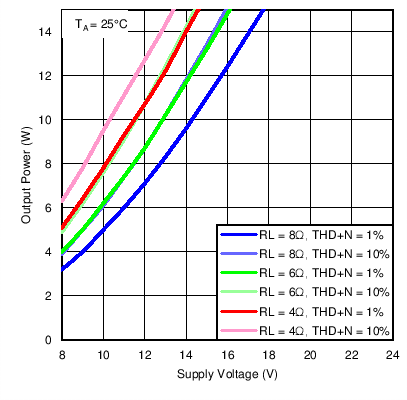
Signal Processing Flow
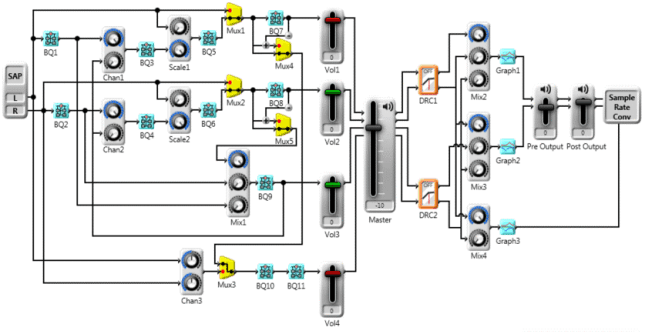
4 Revision History
Changes from * Revision (July 2012) to A Revision
- Added ESD Ratings table, Feature Description section, Device Functional Modes, Application and Implementation section, Power Supply Recommendations section, Layout section, Device and Documentation Support section, and Mechanical, Packaging, and Orderable Information section.Go
5 Device Comparison Table
| TAS5721 | TAS5731M | TAS5729MD | TAS5727 | |
|---|---|---|---|---|
| Max. Power to Single-Ended Load | 10 | 18 | ||
| Max. Power to Bridge Tied Load | 15 | 37 | 20 | 35 |
| Max. Power to Parallel Bridge Tied Load | 30 | 70 | 40 | 70 |
| Min. Supported Single-Ended Load | 4 | 2 | ||
| Min. Supported Bridge Tied Load | 8 | 4 | 4 | 4 |
| Min. Supported Parallel Bridge Tied Load | 4 | 2 | 4 | 2 |
| Closed/Open Loop | Open | Open | Open | Open |
| Max Speaker Outputs (#) | 3 | 3 | 2 | 2 |
| Headphone Channels | Yes | No | Yes | No |
| Architecture | Class D | Class D | Class D | Class D |
| Dynamic Range Control (DRC) | 2-Band DRC | 2-Band DRC | 2-Band AGL | 2-Band AGL |
| Biquads (EQ) | 21 | 21 | 28 | 28 |
6 Pin Configuration and Functions
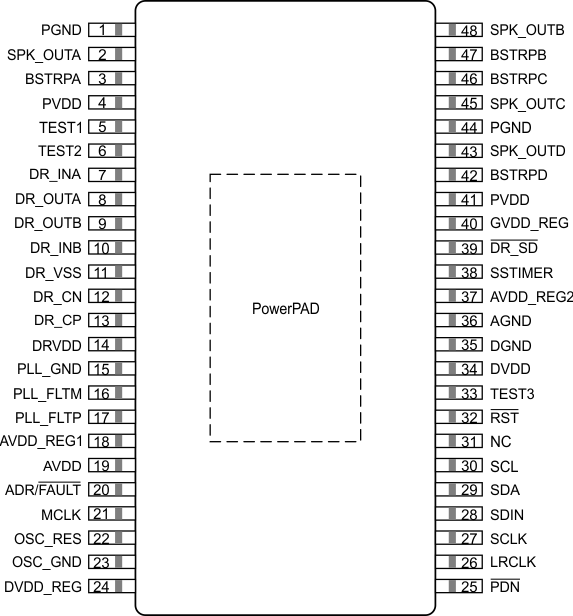
Pin Functions
| PIN | TYPE(1) | TERMINATION | DESCRIPTION | |
|---|---|---|---|---|
| NAME | NO. | |||
| ADR/FAULT | 20 | DI/DO | - | Dual function terminal which sets the LSB of the I2C address to 0 if pulled to GND, 1 if pulled to DVDD. If configured to be a fault output by the methods described in I²C Address Selection and Fault Output, this terminal is pulled low when an internal fault occurs. A pull-up or pull-down resistor is required, as is shown in the Typical Application Circuit Diagrams. |
| AGND | 36 | P | - | Ground reference for analog circuitry(3) |
| AVDD | 19 | P | - | Power supply for internal analog circuitry |
| AVDD_REG1 | 18 | P | - | Voltage regulator derived from AVDD supply(2) |
| AVDD_REG2 | 37 | P | - | Voltage regulator derived from AVDD supply(2) |
| BSTRPx | 3, 42, 46, 47 | P | - | Connection points for the bootstrap capacitors, which are used to create a power supply for the high-side gate drive of the device |
| DGND | 35 | P | - | Ground reference for digital circuitry(3) |
| DR_CN | 12 | P | - | Negative terminal for capacitor connection used in headphone amplifier and line driver charge pump |
| DR_CP | 13 | P | - | Positive terminal for capacitor connection used in headphone amplifier and line driver charge pump |
| DR_INx | 7, 10 | AI | - | Input for channel A or B of headphone amplifier or line driver |
| DR_OUTx | 8, 9 | AO | - | Output for channel A or B of headphone amplifier or line driver |
| DR_SD | 39 | DI | - | Places the headphone amplifier/line driver in shutdown when pulled low. |
| DR_VSS | 11 | P | - | Negative supply generated by charge pump for ground centered headphone and line driver output |
| DRVDD | 14 | P | - | Power supply for internal headphone and line driver circuitry |
| DVDD | 34 | P | - | Power supply for the internal digital circuitry |
| DVDD_REG | 24 | P | - | Voltage regulator derived from DVDD supply(2) |
| GVDD_REG | 40 | P | - | Voltage regulator derived from PVDD supply(2) |
| LRCLK | 26 | DI | Pulldown | Word select clock for the digital signal that is active on the input data line of the serial port |
| MCLK | 21 | DI | Pulldown | Master clock used for internal clock tree and sub-circuit and state machine clocking |
| NC | 31 | - | - | Not connected inside the device (all no connect terminals should be connected to ground) |
| OSC_GND | 23 | P | - | Ground reference for oscillator circuitry (this terminal should be connected to the system ground) |
| OSC_RES | 22 | AO | - | Connection point for oscillator trim resistor |
| PDN | 25 | DI | Pullup | Quick powerdown of the device that is used upon an unexpected loss of PVDD or DVDD power supply in order to quickly transition the outputs of the speaker amplifier to a 50/50 duty cycle. This quick powerdown feature avoids the audible anamolies that would occur as a result of loss of either of the supplies. If this pin is used to place the device into quick powerdown mode, the RST pin of the device must be toggled before the device is brought out of quick powerdown. |
| PGND | 1 | P | - | Ground reference for power device circuitry(3) |
| PLL_FLTM | 16 | AI/AO | - | Negative connection point for the PLL loop filter components |
| PLL_FLTP | 17 | AI/AO | - | Positive connection point for the PLL loop filter components |
| PLL_GND | 15 | P | - | Ground reference for PLL circuitry (this terminal should be connected to the system ground) |
| PowerPAD | - | P | - | Thermal and ground pad thatprovides both an electrical connection to the ground plane and a thermal path to the PCB for heat dissipation. This pad must be grounded to the system ground. |
| PVDD | 4, 41 | P | - | Power supply for internal power circuitry |
| RST | 32 | DI | Pullup | Places the device in reset when pulled low |
| SCL | 30 | DI | - | I2C serial control port clock |
| SCLK | 27 | DI | Pulldown | Bit clock for the digital signal that is active on the input data line of the serial data port |
| SDA | 29 | DI/DO | - | I2C serial control port data |
| SDIN | 28 | DI | Pulldown | Data line to the serial data port |
| SPK_OUTx | 2, 43, 45, 48 | AO | - | Speaker amplifier outputs |
| SSTIMER | 38 | AI | - | Connection point for the capacitor that is used by the ramp timing circuit, as described in Output Mode and MUX Selection |
| TEST1 | 5 | DO | - | Used by TI for testing during device production (this terminal must be left floating) |
| TEST2 | 6 | DO | - | Used by TI for testing during device production (this terminal must be left floating) |
| TEST3 | 33 | DI | - | Used by TI for testing during device production (this terminal must be connected to GND) |
7 Specifications
7.1 Absolute Maximum Ratings
over operating free-air temperature range (unless otherwise noted). (1)| MIN | MAX | UNIT | ||
|---|---|---|---|---|
| Supply voltage | DVDD, AVDD, DRVDD | –0.3 | 3.6 | V |
| PVDD | –0.3 | 30 | V | |
| DR_INx | –0.3 | DRVDD + 6 | V | |
| Input voltage | 3.3-V digital input | –0.5 | DVDD + 0.5 | V |
| 5-V tolerant(2) digital input (except MCLK) | –0.5 | DVDD + 2.5(4) | ||
| 5-V tolerant MCLK input | –0.5 | AVDD + 2.5(4) | ||
| SPK_OUTx to GND | 32(3) | V | ||
| BSTRPx to GND | 39(3) | V | ||
| Operating free-air temperature | 0 | 85 | °C | |
| Storage temperature, Tstg | –40 | 125 | °C | |
7.2 ESD Ratings
| VALUE | UNIT | |||
|---|---|---|---|---|
| V(ESD) | Electrostatic discharge | Human-body model (HBM), per ANSI/ESDA/JEDEC JS-001(1) | ±1000 | V |
| Charged-device model (CDM), per JEDEC specification JESD22-C101(2) | ±250 | |||
7.3 Recommended Operating Conditions
| MIN | NOM | MAX | UNIT | |||
|---|---|---|---|---|---|---|
| xVDD | Digital, analog, headphone supply voltage | 3 | 3.3 | 3.6 | V | |
| PVDD | Half-bridge supply voltage | 8 | 26.4(1) | V | ||
| VIH | High-level input voltage | 5-V tolerant | 2 | V | ||
| VIL | Low-level input voltage | 5-V tolerant | 0.8 | V | ||
| TA | Operating ambient temperature | 0 | 85 | °C | ||
| TJ (2) | Operating junction temperature | 0 | 125 | °C | ||
| RSPK
(SE, BTL, and PBTL) |
Minimum supported speaker impedance | Output filter: L = 15 μH, C = 330 nF | 4 | 8 | Ω | |
| Lo(BTL) | Output-filter inductance | Minimum output inductance under short-circuit condition |
10 | μH | ||
| RHP | Headphone mode load impedance | 16 | 32 | Ω | ||
| RLD | Line-diver mode load impedance | 0.6 | 10 | kΩ | ||
7.4 Thermal Information
| THERMAL METRIC(1) | TAS5721 | UNIT | |
|---|---|---|---|
| DCA (HTSSOP) | |||
| 48 PINS | |||
| RθJA | Junction-to-ambient thermal resistance | 27.9 | °C/W |
| RθJC(top) | Junction-to-case (top) thermal resistance | 20.7 | °C/W |
| RθJB | Junction-to-board thermal resistance | 13 | °C/W |
| ψJT | Junction-to-top characterization parameter | 0.3 | °C/W |
| ψJB | Junction-to-board characterization parameter | 6.7 | °C/W |
| RθJC(bot) | Junction-to-case (bottom) thermal resistance | 1.1 | °C/W |
7.5 Electrical Characteristics – I/O Pin Characteristics
PVDD = 18 V, AVDD = DRVDD = DVDD = 3.3 V, external components per Typical Application diagrams, and in accordance with recommended operating conditions (unless otherwise specified).| PARAMETER | TEST CONDITIONS | MIN | TYP | MAX | UNIT | ||
|---|---|---|---|---|---|---|---|
| VOH | High-level output voltage | ADR/FAULT and SDA | IOH = –4 mA DVDD = AVDD = 3 V |
2.4 | V | ||
| VOL | Low-level output voltage | IOL = 4 mA DVDD = AVDD = 3 V |
0.5 | ||||
| IIL | Low-level input current | Digital Inputs | VI < VIL ; DVDD = AVDD = 3.6 V |
75 | μA | ||
| IIH | High-level input current | VI > VIH ; DVDD = AVDD = 3.6 V |
75 | ||||
| IDD | 3.3 V supply current | 3.3 V supply voltage (DVDD, AVDD) | Normal mode | 48 | 70 | mA | |
| Reset (RST = low, PDN = high, DR_SD = low) | 21 | 38 | |||||
| tw(RST) | Pulse duration, RST active | RST | 100 | μs | |||
| td(I2C_ready) | Time before the I2C port is able communicate after RST goes high | 12 | ms | ||||
7.6 Master Clock Characteristics(1)
PVDD = 18 V, AVDD = DRVDD = DVDD = 3.3 V, external components per Typical Application diagrams, and in accordance with recommended operating conditions (unless otherwise specified).| PARAMETER | TEST CONDITIONS | MIN | TYP | MAX | UNIT | |
|---|---|---|---|---|---|---|
| fMCLK | MCLK frequency | 2.8224 | 24.576 | MHz | ||
| MCLK duty cycle | 40% | 50% | 60% | |||
| tr(MCLK) / tf(MCLK) | Rise/fall time for MCLK | 5 | ns | |||
7.7 Speaker Amplifier Characteristics
TA = 25°C, PVDD = 18 V, AVDD = DRVDD = DVDD = 3.3 V, audio input signal =1 kHz sine wave, BTL, AD mode, fS = 48 kHz, RSPK = 8 Ω, AES17 filter, fPWM = 384 kHz, external components per Typical Application diagrams, and in accordance with recommended operating conditions (unless otherwise specified).| PARAMETER | TEST CONDITIONS | MIN | TYP | MAX | UNIT | ||
|---|---|---|---|---|---|---|---|
| PoSPK (BTL) | Power output per channel of speaker amplifier when used in BTL mode (2) | PVDD = 18 V, RSPK = 8Ω, 1-kHz input signal | 10 | W | |||
| PVDD = 12 V, RSPK = 8Ω, 10% THD+N, 1-kHz input signal | 8.8 | ||||||
| PVDD = 12 V, RSPK = 8Ω, 7% THD+N, 1-kHz input signal | 8.3 | ||||||
| PVDD = 8 V, RSPK = 8Ω, 10% THD+N, 1-kHz input signal | 4 | ||||||
| PVDD = 8 V, RSPK = 8Ω, 7% THD+N, 1-kHz input signal | 3.8 | ||||||
| PoSPK (PBTL) | Power output per channel of speaker amplifier when used in PBTL mode (2) | PVDD = 12 V, RSPK = 4Ω, 10% THD+N, 1-kHz input signal |
10 | W | |||
| PVDD = 12 V, RSPK = 4Ω, 7% THD+N, 1-kHz input signal |
10 | ||||||
| PVDD = 18 V, RSPK = 4Ω, 1-kHz input signal |
10 | ||||||
| PoSPK (SE) | Power output per channel of speaker amplifier when used in SE mode (2) | PVDD = 12 V, RSPK = 4 Ω, 10% THD+N, 1-kHz input signal |
4.3 | W | |||
| PVDD = 24 V, RSPK = 4 Ω, 10% THD+N, 1-kHz input signal |
5.5 | ||||||
| THD+N | Total harmonic distortion + noise | PVDD = 18 V, PO = 1 W | 0.07% | ||||
| PVDD = 12 V, PO = 1 W | 0.11% | ||||||
| PVDD = 8 V, PO = 1 W | 0.2% | ||||||
| ICN | Idle channel noise | A-weighted | 61 | μV | |||
| Crosstalk | PO = 1 W, f = 1 kHz (BD Mode), PVDD = 24 V | 58 | dB | ||||
| PO =1 W, f = 1 kHz (AD Mode), PVDD = 24 V | 48 | dB | |||||
| SNR | Signal-to-noise ratio(1) | A-weighted, f = 1 kHz, maximum power at THD < 1% | 106 | dB | |||
| fPWM | Output switching frequency | 11.025/22.05/44.1-kHz data rate ±2% | 352.8 | kHz | |||
| 48/24/12/8/16/32-kHz data rate ±2% | 384 | ||||||
| IPVDD | Supply current | No load (PVDD) | Normal mode | 32 | 50 | mA | |
| Reset (RST = low, PDN = high) | 5 | 8 | |||||
| rDS(on) | Drain-to-source resistance (for each of the Low-Side and High-Side Devices) | TJ = 25°C, includes metallization resistance | 200 | mΩ | |||
| RPD | Internal pulldown resistor at the output of each half-bridge | Connected when drivers are in the high-impedance state to provide bootstrap capacitor charge. | 3 | kΩ | |||
7.8 Headphone Amplifier and Line Driver Characteristics
TA = 25°C, PVDD = 18 V, AVDD = DRVDD = DVDD = 3.3 V, audio input signal =1 kHz sine wave, BTL, AD mode, fS = 48 kHz, RSPK = 8 Ω, AES17 filter, fPWM = 384 kHz, external components per Typical Application diagrams, and in accordance with recommended operating conditions (unless otherwise specified).| PARAMETER | TEST CONDITIONS | MIN | TYP | MAX | UNIT | |
|---|---|---|---|---|---|---|
| PoHP | Power output per channel of headphone amplifier | DRVDD = 3.3 V (RHP = 32; THD = 1%) | 50 | mW | ||
| AVDR | Gain for headphone amplifier and line driver | Adjustable through Rin and Rfb | - | dB | ||
| SNRHP | Signal-to-noise ratio (headphone mode) | Rhp = 32 | 101 | dB | ||
| SNRLD | Signal-to-noise ratio (line driver mode) | 2-VRMS output | 105 | dB | ||
7.9 Protection Characteristics
TA = 25°C, PVDD = 18 V, AVDD = DRVDD = DVDD = 3.3 V, audio input signal =1 kHz sine wave, BTL, AD mode, fS = 48 kHz, RSPK = 8 Ω, AES17 filter, fPWM = 384 kHz, external components per Typical Application diagrams, and in accordance with recommended operating conditions (unless otherwise specified).| MIN | TYP | MAX | UNIT | ||||
|---|---|---|---|---|---|---|---|
| Vuvp(fall) | Undervoltage protection limit | PVDD falling | 4 | V | |||
| Vuvp(rise) | Undervoltage protection limit | PVDD rising | 4.1 | V | |||
| OTE | Overtemperature error threshold | 150 | °C | ||||
| ΔOTE | Variation in overtemperature detection circuit | ±15 | °C | ||||
| IOCE | Overcurrent limit protection threshold | 3 | A | ||||
| tOCE | Overcurrent response time | 150 | ns | ||||
7.10 I2C Serial Control Port Requirements and Specifications
PVDD = 18 V, AVDD = DRVDD = DVDD = 3.3 V, external components per Typical Application diagrams, and in accordance with recommended operating conditions (unless otherwise specified).| MIN | MAX | UNIT | |||
|---|---|---|---|---|---|
| fSCL | Frequency, SCL | No wait states | 400 | kHz | |
| tw(H) | Pulse duration, SCL high | 0.6 | μs | ||
| tw(L) | Pulse duration, SCL low | 1.3 | μs | ||
| tr | Rise time, SCL and SDA | 300 | ns | ||
| tf | Fall time, SCL and SDA | 300 | ns | ||
| tsu1 | Setup time, SDA to SCL | 100 | ns | ||
| th1 | Hold time, SCL to SDA | 0 | ns | ||
| t(buf) | Bus free time between stop and start conditions | 1.3 | μs | ||
| tsu2 | Setup time, SCL to start condition | 0.6 | μs | ||
| th2 | Hold time, start condition to SCL | 0.6 | μs | ||
| tsu3 | Setup time, SCL to stop condition | 0.6 | μs | ||
| CL | Load capacitance for each bus line | 400 | pF | ||
7.11 Serial Audio Port Timing
PVDD = 18 V, AVDD = DRVDD = DVDD = 3.3 V, audio input signal =1 kHz sine wave, BTL, AD mode, fS = 48 kHz, RSPK = 8 Ω, AES17 filter, fPWM = 384 kHz, external components per Typical Application diagrams, and in accordance with recommended operating conditions (unless otherwise specified).| MIN | TYP | MAX | UNIT | |||
|---|---|---|---|---|---|---|
| fSCLKIN | Frequency, SCLK 32 × fS, 48 × fS, 64 × fS | CL = 30 pF | 1.024 | 12.288 | MHz | |
| tsu1 | Setup time, LRCLK to SCLK rising edge | 10 | ns | |||
| th1 | Hold time, LRCLK from SCLK rising edge | 10 | ns | |||
| tsu2 | Setup time, SDIN to SCLK rising edge | 10 | ns | |||
| th2 | Hold time, SDIN from SCLK rising edge | 10 | ns | |||
| LRCLK frequency | 8 | 48 | 48 | kHz | ||
| SCLK duty cycle | 40% | 50% | 60% | |||
| LRCLK duty cycle | 40% | 50% | 60% | |||
| SCLK rising edges between LRCLK rising edges | 32 | 64 | SCLK edges | |||
| t(edge) | LRCLK clock edge with respect to the falling edge of SCLK | –1/4 | 1/4 | SCLK period | ||
| tr/tf | Rise/fall time for SCLK/LRCLK | 8 | ns | |||
| LRCLK allowable drift before LRCLK reset | 4 | MCLK Periods | ||||
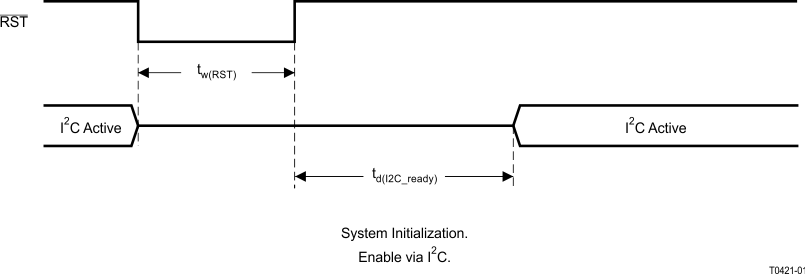
NOTE:
On power up, it is recommended that the TAS5721 RST be held LOW for at least 100 μs after DVDD has reached 3 V.NOTE:
If RST is asserted LOW while PDN is LOW, then RST must continue to be held LOW for at least 100 μs after PDN is deasserted (HIGH). Figure 2. SCL and SDA Timing
Figure 2. SCL and SDA Timing
 Figure 3. Start and Stop Conditions Timing
Figure 3. Start and Stop Conditions Timing
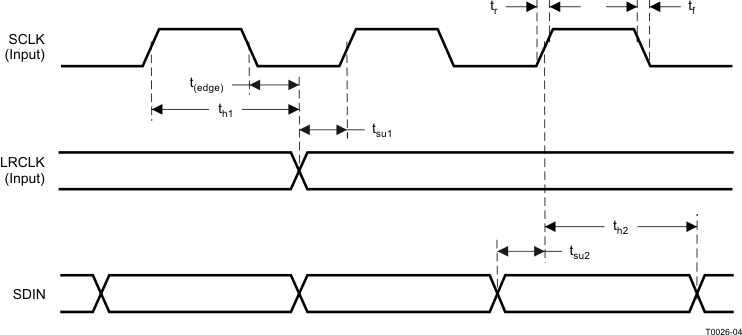 Figure 4. Serial Audio Port Timing
Figure 4. Serial Audio Port Timing
7.12 Typical Characteristics
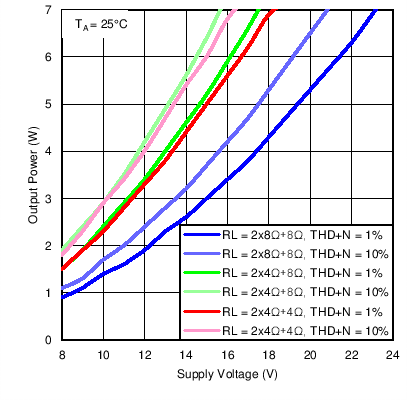 Figure 5. Output Power vs PVDD IN 2.1 Mode
Figure 5. Output Power vs PVDD IN 2.1 Mode
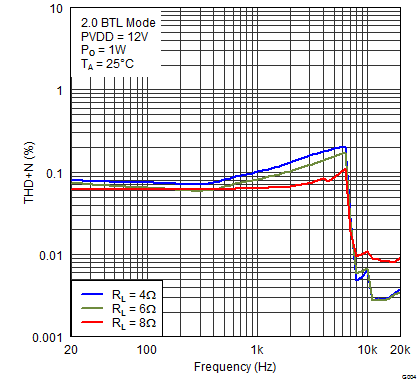 Figure 7. Total Harmonic Distortion + Noise vs Frequency in 2.0 Mode With PVDD = 12 V
Figure 7. Total Harmonic Distortion + Noise vs Frequency in 2.0 Mode With PVDD = 12 V
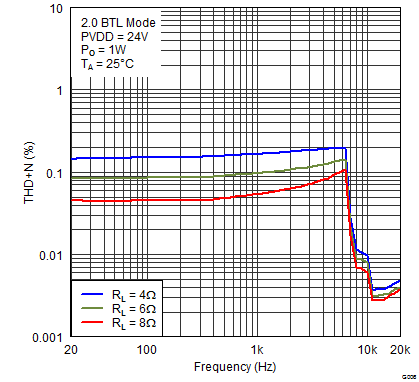 Figure 9. Total Harmonic Distortion + Noise vs Frequency in 2.0 Mode With PVDD = 24 V
Figure 9. Total Harmonic Distortion + Noise vs Frequency in 2.0 Mode With PVDD = 24 V
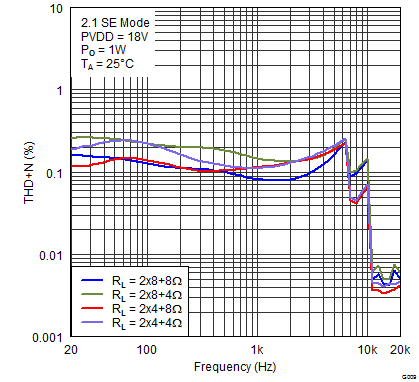 Figure 11. Total Harmonic Distortion + Noise vs Frequency in 2.1 Mode With PVDD = 18 V
Figure 11. Total Harmonic Distortion + Noise vs Frequency in 2.1 Mode With PVDD = 18 V
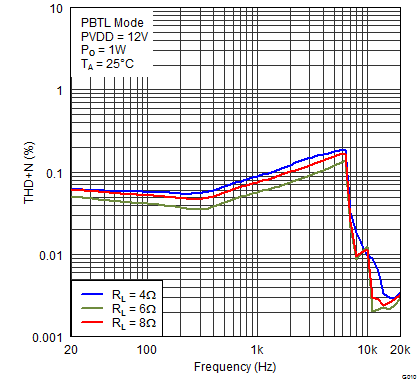 Figure 13. Total Harmonic Distortion + Noise vs Frequency in PBTL Mode With PVDD = 12 V
Figure 13. Total Harmonic Distortion + Noise vs Frequency in PBTL Mode With PVDD = 12 V
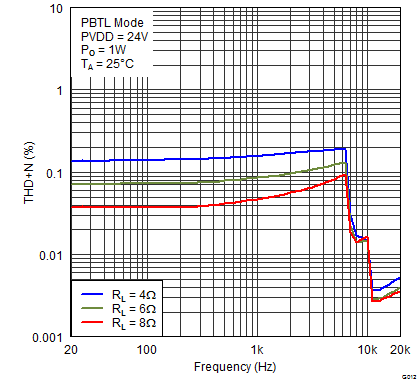 Figure 15. Total Harmonic Distortion + Noise vs Frequency in PBTL Mode With PVDD = 24 V
Figure 15. Total Harmonic Distortion + Noise vs Frequency in PBTL Mode With PVDD = 24 V
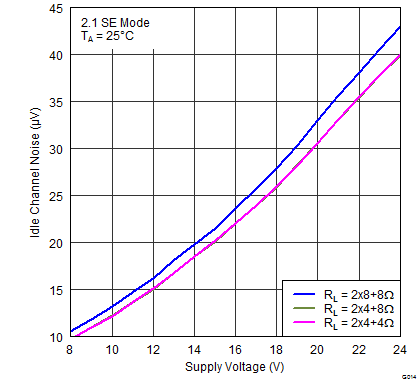 Figure 17. 2.1 Idle Channel Noise vs PVDD
Figure 17. 2.1 Idle Channel Noise vs PVDD
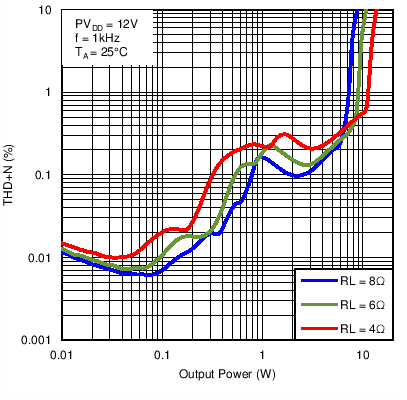 Figure 19. Total Harmonic Distortion + Noise vs Output Power in 2.0 Mode With PVDD = 12 V
Figure 19. Total Harmonic Distortion + Noise vs Output Power in 2.0 Mode With PVDD = 12 V
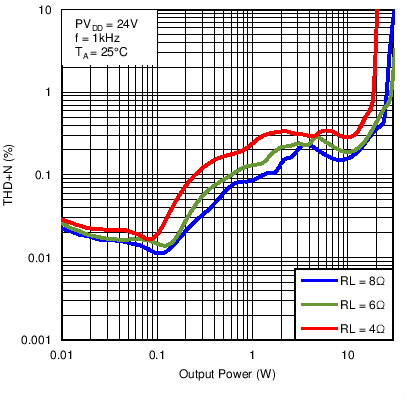 Figure 21. Total Harmonic Distortion + Noise vs Output Power in 2.0 Mode With PVDD = 24 V
Figure 21. Total Harmonic Distortion + Noise vs Output Power in 2.0 Mode With PVDD = 24 V
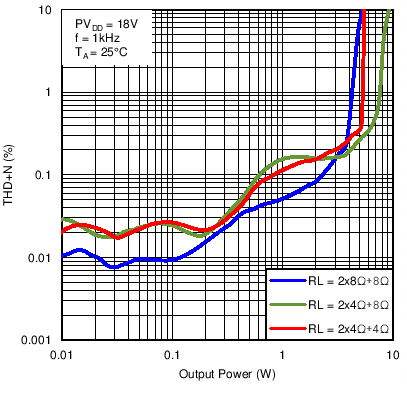 Figure 23. Total Harmonic Distortion + Noise vs Output Power in 2.1 Mode With PVDD = 18 V
Figure 23. Total Harmonic Distortion + Noise vs Output Power in 2.1 Mode With PVDD = 18 V
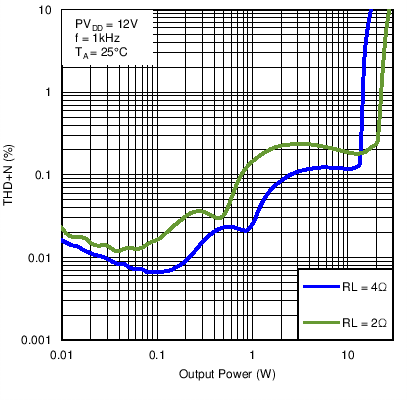 Figure 25. Total Harmonic Distortion + Noise vs Output Power in PBTL Mode With PVDD = 12 V
Figure 25. Total Harmonic Distortion + Noise vs Output Power in PBTL Mode With PVDD = 12 V
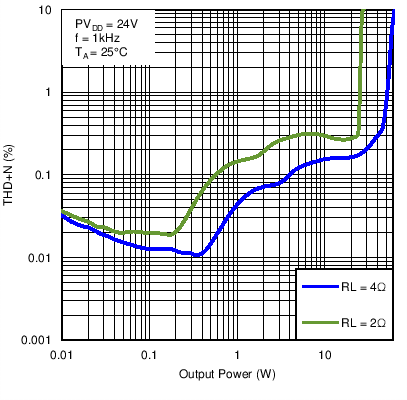 Figure 27. Total Harmonic Distortion + Noise vs Output Power in PBTL Mode With PVDD = 24 V
Figure 27. Total Harmonic Distortion + Noise vs Output Power in PBTL Mode With PVDD = 24 V
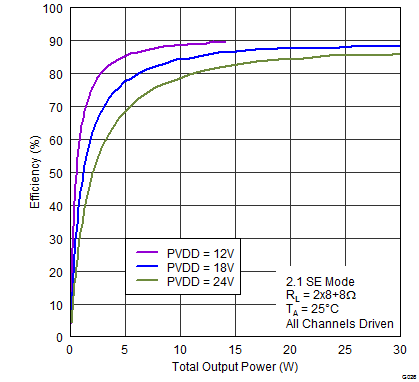
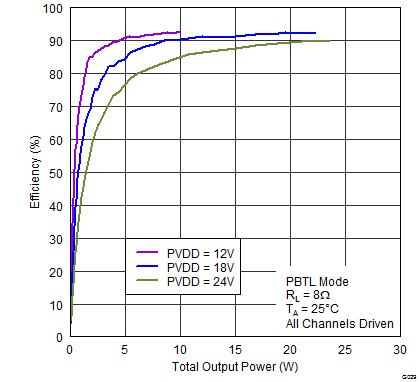
 Figure 33. Crosstalk vs Frequency in 2.0 Mode
Figure 33. Crosstalk vs Frequency in 2.0 Mode
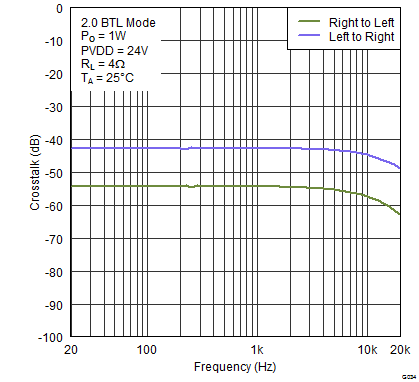 Figure 35. Crosstalk vs Frequency in 2.0 Mode
Figure 35. Crosstalk vs Frequency in 2.0 Mode
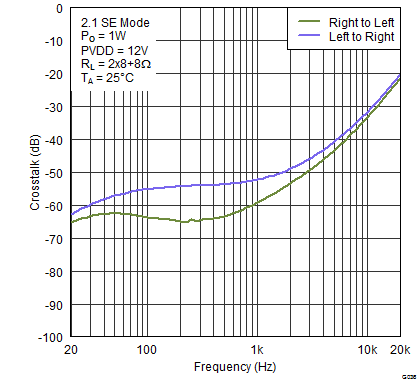 Figure 37. Crosstalk vs Frequency in 2.1 Mode
Figure 37. Crosstalk vs Frequency in 2.1 Mode
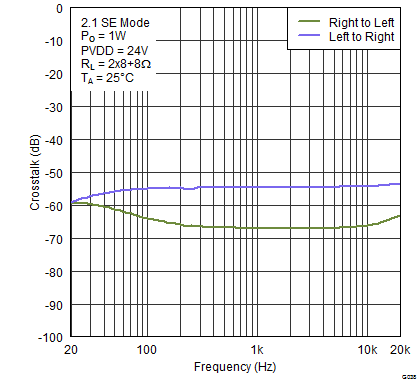 Figure 39. Crosstalk vs Frequency in 2.1 Mode
Figure 39. Crosstalk vs Frequency in 2.1 Mode
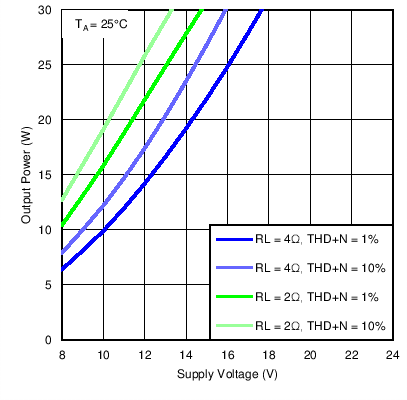 Figure 6. Output Power vs PVDD in PBTL Mode
Figure 6. Output Power vs PVDD in PBTL Mode
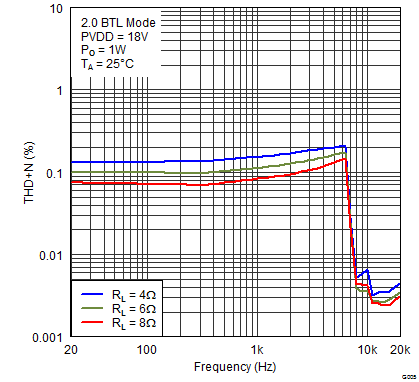 Figure 8. Total Harmonic Distortion + Noise vs Frequency in 2.0 Mode With PVDD = 18 V
Figure 8. Total Harmonic Distortion + Noise vs Frequency in 2.0 Mode With PVDD = 18 V
 Figure 10. Total Harmonic Distortion + Noise vs Frequency in 2.1 Mode With PVDD = 12 V
Figure 10. Total Harmonic Distortion + Noise vs Frequency in 2.1 Mode With PVDD = 12 V
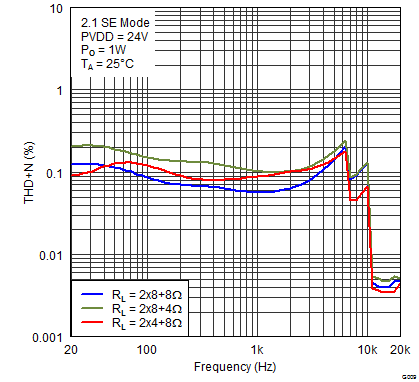 Figure 12. Total Harmonic Distortion + Noise vs Frequency in 2.1 Mode With PVDD = 24 V
Figure 12. Total Harmonic Distortion + Noise vs Frequency in 2.1 Mode With PVDD = 24 V
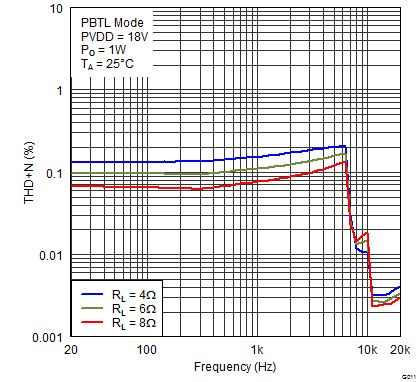 Figure 14. Total Harmonic Distortion + Noise vs Frequency in PBTL Mode With PVDD = 18 V
Figure 14. Total Harmonic Distortion + Noise vs Frequency in PBTL Mode With PVDD = 18 V
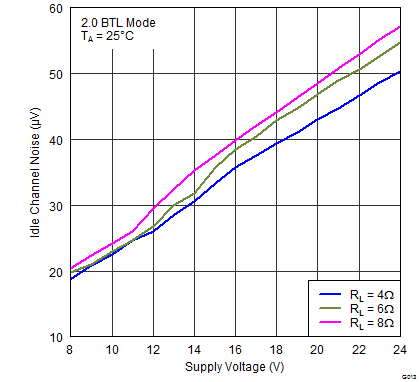 Figure 16. 2.0 Idle Channel Noise vs PVDD
Figure 16. 2.0 Idle Channel Noise vs PVDD
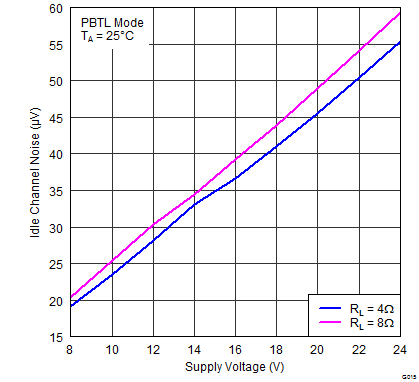 Figure 18. PBTL Idle Channel Noise vs PVDD
Figure 18. PBTL Idle Channel Noise vs PVDD
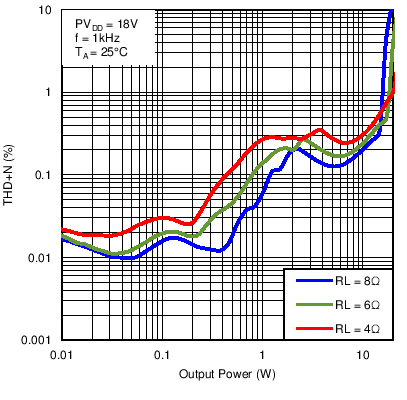 Figure 20. Total Harmonic Distortion + Noise vs Output Power in 2.0 Mode With PVDD = 18 V
Figure 20. Total Harmonic Distortion + Noise vs Output Power in 2.0 Mode With PVDD = 18 V
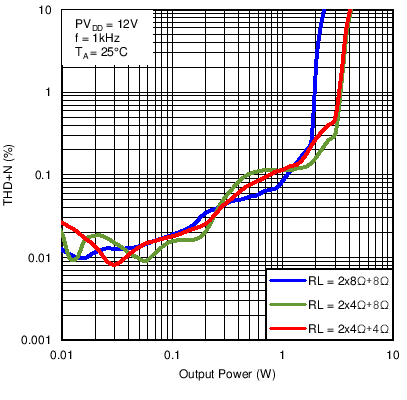 Figure 22. Total Harmonic Distortion + Noise vs Output Power in 2.1 Mode With PVDD = 12 V
Figure 22. Total Harmonic Distortion + Noise vs Output Power in 2.1 Mode With PVDD = 12 V
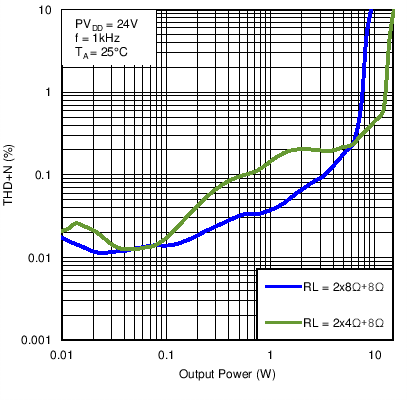 Figure 24. Total Harmonic Distortion + Noise vs Output Power in 2.1 Mode With PVDD = 24 V
Figure 24. Total Harmonic Distortion + Noise vs Output Power in 2.1 Mode With PVDD = 24 V
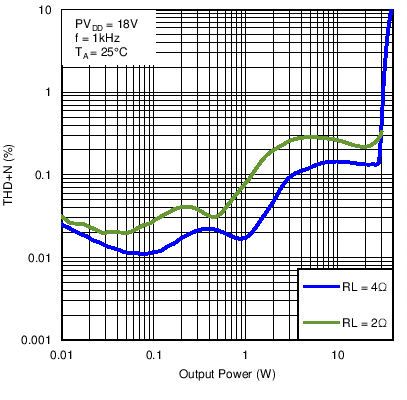 Figure 26. Total Harmonic Distortion + Noise vs Output Power in PBTL Mode With PVDD = 18 V
Figure 26. Total Harmonic Distortion + Noise vs Output Power in PBTL Mode With PVDD = 18 V
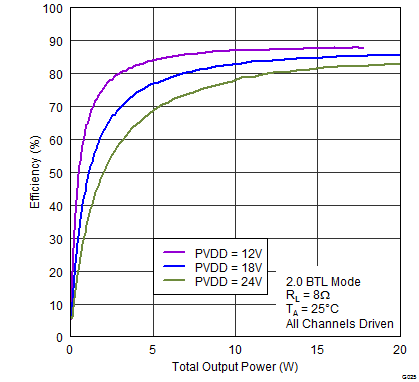
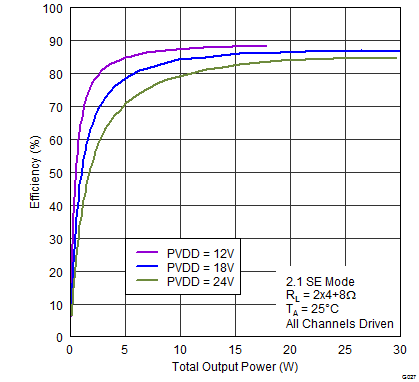

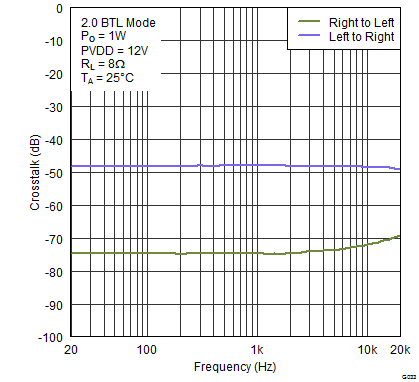 Figure 34. Crosstalk vs Frequency in 2.0 Mode
Figure 34. Crosstalk vs Frequency in 2.0 Mode
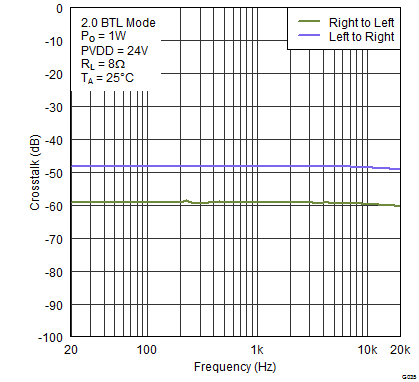 Figure 36. Crosstalk vs Frequency in 2.0 Mode
Figure 36. Crosstalk vs Frequency in 2.0 Mode
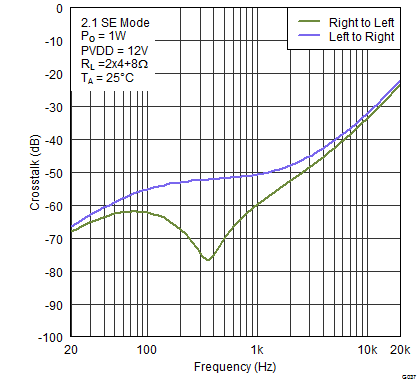 Figure 38. Crosstalk vs Frequency in 2.1 Mode
Figure 38. Crosstalk vs Frequency in 2.1 Mode
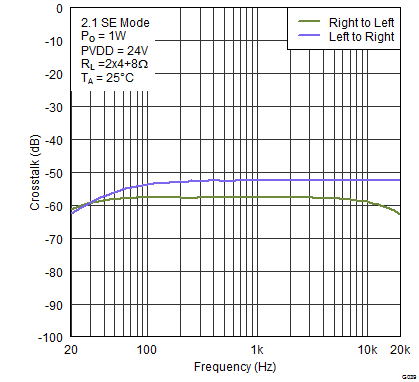 Figure 40. Crosstalk vs Frequency in 2.1 Mode
Figure 40. Crosstalk vs Frequency in 2.1 Mode
7.12.1 Headphone Typical Characteristics
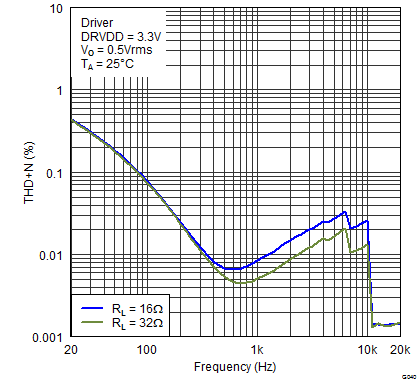 Figure 41. Total Harmonic Distortion + Noise vs Frequency Headphone With DRVDD = 3.3 V
Figure 41. Total Harmonic Distortion + Noise vs Frequency Headphone With DRVDD = 3.3 V
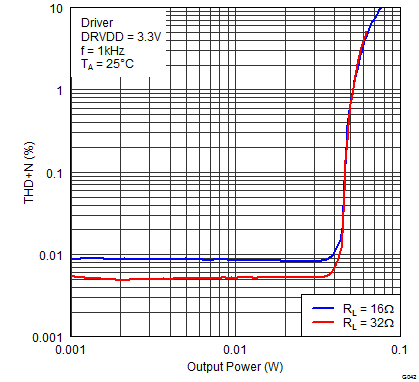 Figure 43. Total Harmonic Distortion + Noise vs Output Power Headphone With DRVDD = 3.3 V
Figure 43. Total Harmonic Distortion + Noise vs Output Power Headphone With DRVDD = 3.3 V
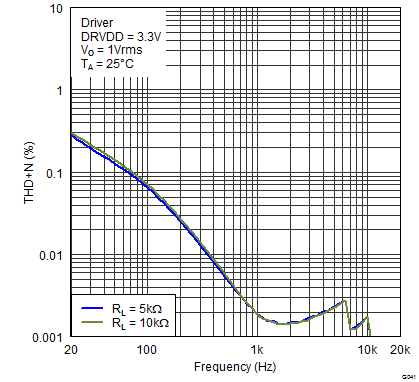 Figure 42. Total Harmonic Distortion + Noise vs Frequency Headphone With DRVDD = 3.3 V
Figure 42. Total Harmonic Distortion + Noise vs Frequency Headphone With DRVDD = 3.3 V
7.12.2 Line Driver Typical Characteristics
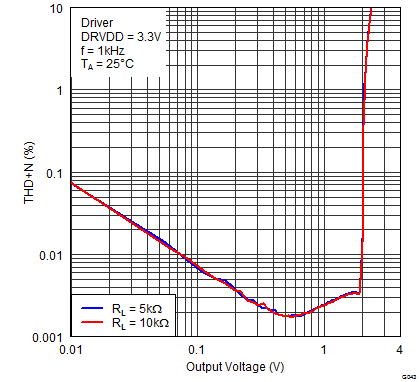 Figure 44. Total Harmonic Distortion + Noise vs Output Voltage Headphone With DRVDD = 3.3 V
Figure 44. Total Harmonic Distortion + Noise vs Output Voltage Headphone With DRVDD = 3.3 V
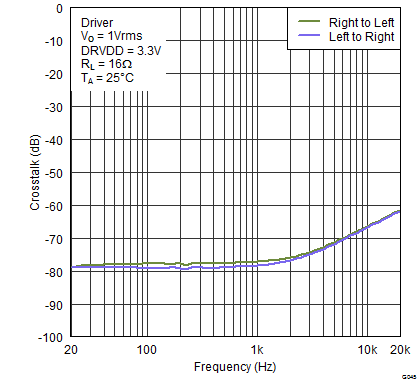 Figure 46. Crosstalk vs Frequency Headphone With DRVDD = 3.3 V
Figure 46. Crosstalk vs Frequency Headphone With DRVDD = 3.3 V
 Figure 45. Crosstalk vs Frequency Headphone With DRVDD = 3.3 V
Figure 45. Crosstalk vs Frequency Headphone With DRVDD = 3.3 V
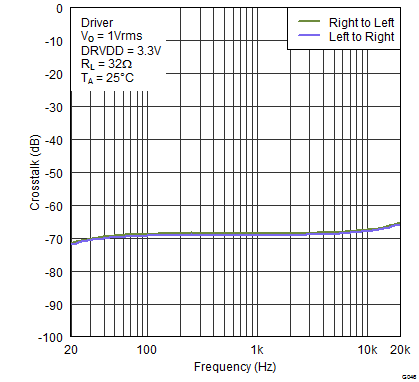 Figure 47. Crosstalk vs Frequency Headphone With DRVDD = 3.3 V
Figure 47. Crosstalk vs Frequency Headphone With DRVDD = 3.3 V